
95% of researchers rate our articles as excellent or good
Learn more about the work of our research integrity team to safeguard the quality of each article we publish.
Find out more
ORIGINAL RESEARCH article
Front. Sustain. Food Syst. , 17 March 2025
Sec. Sustainable Food Processing
Volume 9 - 2025 | https://doi.org/10.3389/fsufs.2025.1560403
 Tengyu Wang1
Tengyu Wang1 Zuoxing Huang2
Zuoxing Huang2 Ning Zhang1
Ning Zhang1 Kashaf Kareem3
Kashaf Kareem3 Xinwen Sun1
Xinwen Sun1 Cuiling Shang1*
Cuiling Shang1* Dengke Hua1*
Dengke Hua1* Xinfeng Wang1*
Xinfeng Wang1*Background: The objective of this study was to determine the optimal level of molasses required for ensiling the seed-used zucchini peel residue and corn stalks mixtures, using a 2:1 ratio of seed-used zucchini peel residue to corn stalks. The experiment included a control group (CON, with no molasses added), a 1% molasses group (M1, 10 g kg−1 fresh matter), a 2% molasses group (M2, 20 g kg−1 fresh matter), and a 3% molasses group (M3, 30 g kg−1 fresh matter). After 60 days of fermentation, samples of the silage were collected and analyzed for their chemical composition, fermentation quality, aerobic stability, and ruminal degradation characteristics.
Result: Compared to the CON group, the addition of molasses significantly decreased both the pH and the ratio of ammonia nitrogen to total nitrogen (NH3-N/TN) in the ensilage mixture of seed-used zucchini peel residue and corn stalks. In the molasses-treated groups, the pH values decreased by 0.08, 0.09, and 0.13, respectively, compared to the control group. The NH3-N/TN ratios decreased by 1.52, 1.86, and 2.24, respectively, compared to the control group. Additionally, the contents of neutral detergent fiber (NDF) and acid detergent fiber (ADF) in the silage with molasses were significantly lower than those in the CON group. However, the addition of molasses reduced the aerobic stability of the feed, with the 3% molasses-added group showing a significant decrease in aerobic stability. Furthermore, the addition of molasses significantly improved the ruminal degradation rates of the silage, with the M3 group showing ruminal degradation rates of dry matter (DM), crude protein (CP), and ADF at 65.49, 55.26, and 46.18%, respectively.
Conclusion: The addition of molasses is beneficial for improving the quality of the ensilage mixture of seed-used zucchini peel residue and corn stalks, improving the nutritional components and increasing the ruminal degradation rate.
The residue that remains after corn has fully grown and harvested is known as corn stalks. These stalks are abundant in quantity and can be used as feed for ruminants (Wang et al., 2024). Corn stalks contain a large amount of cellulose, while their protein and sugar contents are low. Consequently, the utilization rate is rather low when directly fed to livestock (Fu et al., 2023). To extend the storage life of corn stalks, reduce nutrient loss, and prevent mildew, they are usually processed into fermented feed. However, due to the relatively low water content and nutritional value of corn stalks, additional water and additives are necessary to produce high-quality fermented feed. Research has shown that adding amaranth with has a relatively high water content, along with glucose, lactic acid bacteria, and cellulase to corn stalks, can significantly enhance the nutritional value of the feed (Ma et al., 2023).
The seed-used zucchini (Cucurbita pepo) is an annual herbaceous cash crop of the family Cucurbitaceae. The peel residue of seed-used zucchini, which accounts for approximately 95% of the entire zucchini, is the part of the peel and pulp left over after the seeds are removed (Liu et al., 2023). Zucchini grown from seeds offers several advantages, including high yield, relatively simple cultivation, and high nutritional content. To date, research on the peel residue of seed-used zucchini is limited and primarily focuses on zucchini seeds. The peel residue of seed-used zucchini has a high water content and is not easy to store. It is usually abandoned directly in the field after the seeds are taken. In Xinjiang alone, the annual output of seeded zucchini peel residue is approximately 13.15 × 106 tons (Hou et al., 2023). Making full use of the peel residue of seed-used zucchini can effectively reduce resource waste. Current studies indicate that it is challenging to produce high-quality silage when mixing the peel residue of seed-used zucchini with wheat straw, probably due to insufficient water soluble carbohydrates (WSC) content (Liu et al., 2023). Meanwhile, this was also confirmed by Wang et al. (2020), who ensilaged the seed cucurbits with wheatgrass and obtained a feed with a pH of 5.24, which did not meet the standard of high quality fermented feed. Researchers have found that adding molasses to Pennisetum purpureum, which has low soluble sugar content can, promote the feed fermentation process in feed and lower the pH value (Li et al., 2017). Molasses, a by-product of sugar extraction, is produced globally and is an excellent source of fermentable sugars (Palmonari et al., 2020). The addition of 1% molasses to a mixture of seed pumpkin and sunflower straw has been shown to significantly improve the quality of micro silage (Yao et al., 2024). In addition the addition of 2 and 4% molasses to fresh corn stover significantly improved silage quality (Zhang et al., 2024). To determine whether molasses can help address the quality issue in the silage, we conducted an ensilaging experiment using the peel residual of seed-used zucchini combined with corn stalks and supplemented with molasses.
This study will focus on evaluating the effects of adding different amounts of molasses on the fermentation quality, aerobic stability and ruminal degradation characteristics of the ensilage mixture of seed-used zucchini peel residue and corn stalks. These findings may provide valuable references for further applications and feeding strategies.
Both the corn stalks and the peel residue of seed-used zucchini were sourced from the 183rd Regiment of the Agricultural 10th Division of the Xinjiang Production and Construction Corps. The corn stalks were collected after the corn harvest and then chopped into pieces approximately 2–3 centimeters long. After the seeds were removed from the zucchinis, the remaining parts were crushed into a paste using a crusher. These parts do not contain any vines or leaves. Molasses was utilized as an additive for the ensilage mixture.
The processed peel residue of seed-used zucchini and corn stalks was mixed at a dry matter ratio of 2:1 to create equal weights for four treatments: without molasses addition (CON), with 1% molasses addition (M1), with 2% molasses addition (M2), and with 3% molasses addition (M3). The amount of molasses added was calculated based on grams of fresh materials. In this experiment, molasses was mixed with water at a 1:1 ratio (w/v) and then spray the mixture onto the raw materials. In addition, each treatment was supplemented with 0.2% compound bacterial liquid (Lactobacillus plantarum ≥ 2.5 × 107 CFU/mL, Lactobacillus lactis ≥ 1.0 × 106 CFU/mL, Saccharomyces cerevisiae ≥ 2.5 × 107 CFU/mL, Candida tropicalis ≥ 1.0 × 106 CFU/mL), 0.1% urea and 0.2% crude salt. Finally, the moisture content was adjusted to 65%. After evenly mixing the materials, they were packed into 2 L anaerobic fermentation bags, vacuum sealed, labeled and stored at ambient temperature (20–25°C). A total of 24 bags were prepared (4 treatments, with 6 replicates for each treatment). After 60 days of fermentation, the bags were opened and samples were collected for analysis of chemical composition, fermentation quality, aerobic stability, and ruminal degradation characteristics. The chemical compositions of the seed-used zucchini peel residue and corn stover are presented in Table 1.
Some fresh samples of the silage after 60 days were placed into an oven (LBAO-250; Shanghai Sidike Instrument and Equipment Co., Ltd., Shanghai, China) and dried at 65°C for 48 h. Afterward, they were removed from the oven and allowed to absorb moisture for 24 h. Subsequently, the samples were crushed using a crusher (FS200; Guangzhou Bomin Electromechanical Equipment Co., Ltd., Guangzhou, China) and sieved through 1.0 mm and 2.0 mm mesh, respectively. The dry matter (DM), crude protein (CP), and crude fat (EE) were determined by the AOAC method (AOAC International, 2019). The neutral detergent fiber (NDF) and acidic detergent fiber (ADF) were analyzed according to the method described in the previous report (Van Soest et al., 1991).
The fermentation quality was assessed after 60 days of silage and after 0, 3, 6, and 9 days of aerobic exposure. A sample of 20 g from each treatment was mixed with 180 mL of distilled water. After sealing with parafilm, the mixture was stored in a 4°C refrigerator for 24 h until extraction. The extract was then filtered through four layers of gauze and qualitative filter paper. After filtration, the pH of the extracted solution was determined using a digital pH meter (PHBJ-260F; Shanghai INESA Scientific Instrument Co., Ltd.). The ammonia nitrogen concentration was measured using the phenol-sodium hypochlorite method (Broderick and Kang, 1980). The WSC concentration was determined by the sulfuric acid-anthrone colorimetric method (Yemm and Willis, 1954). Organic acids were quantified using high-performance liquid chromatography (1,260 Infinity II; Agilent Technologies, Waldbronn, Germany) as described by Xie et al. (2023).
We took 250 g of fresh samples from each bag and loosely placed them into correspondingly labeled 1,000 mL wide-mouth polyethylene bottles. The probes of the multi-channel temperature recorder were inserted to estimate the aerobic stability, resulting in a total of 24 bottles. The bottle mouths of the bottles were covered with two layers of gauze to minimize water evaporation and prevent dust entry. Samples were collected on days 0, 3, 6, and 9 following aerobic exposure, to determine the counts of lactic acid bacteria, yeasts, and molds using the plate counting method as described by Yu et al. (2023). Aerobic stability was measured as the time (h) before the silage temperature exceeded the ambient temperature by 2°C (Xie et al., 2022).
In this study, three healthy Kazakh rams aged 8 months (weighing 30 ± 3.5 kg) with permanent ruminal fistulas were selected to determine the ruminal degradation rates of the samples. The basal diet was formulated according to the nutritional requirements for mutton sheep as regulated by NY/T 816–2021, maintaining a concentrate feed to roughage ratio of 4:6. The rams were fed twice daily (at 09:00 and 18:00) and had free access to water. The nutrient levels of the basal diet are shown in Table 2.
Three grams of the crushed samples, which had passed through a 2 mm sieve, were placed into nylon bags (10 cm × 6 cm size, with a pore size of 50 μm). After sealing, the nylon bags were attached to one end of a semi-flexible PVC hose and placed into the rumen prior to the morning feeding. The other end of the hose was secured to the fistula. The feed samples were incubated in the rumen for 4, 8, 12, 24, 48, and 72 h. Each sample was replicated three times at each time point, with each replicate corresponding to one sheep. Each sample was replicated three times at each time point, with each replicate corresponding to one sheep. Two parallel samples of the same type were placed into the rumen of each sheep. After specified incubation periods, the samples were removed from the nylon bags, placed into ice boxes, and thoroughly rinsed under tap water. Then, they were dried in an oven at 65°C until reaching a constant weight. Following this, the samples were crushed and sieved through a 1-mm mesh for the measurement and calculation of the ruminal degradation rates, as well as degradation parameters (a, b, and c), and effective degradation rate (ED) of DM, CP, NDF, and ADF. The ruminal degradation rate at a specific time was calculated according to the formula A = (B – C)/B, where A represents the degradation rate of ruminants at that specific time, B represents the total amount of nutrients before degradation (determined by multiplying the initial weight before degradation by its nutrient content), and C represents the total amount of nutrients after degradation (obtained by multiplying the final weight after degradation by its nutrient content).
The ruminal degradation parameters were calculated using the model , and the effective degradation rate , following references from previous studies (Ørskov and McDonald, 1979). In these formulas, P represents the degradation rate (%) of the feed nutrient component after time in the rumen; a represents the rapidly degradable fraction (%); b represents the slowly degradable fraction (%); c represents the degradation rate of b (%/h); k represents the ruminal outflow rate (%/h) of a specific target component from the sample with the k value for this experiment being 0.0253%/h (Shi et al., 2022).
One-way analysis of variance (ANOVA) was conducted using IBM SPSS Statistics software to analyze the data on chemical composition and fermentation quality parameters affected by the addition of molasses. Two-way ANOVA was used to assess the fixed effects of molasses addition levels, aerobic exposure time, and their interaction (molasses addition levels D × aerobic exposure time T) using the general linear model procedure in SPSS. Post hoc analyses were carried out using the Duncan test to compute pairwise differences in the means. Data are presented as means and standard error of the mean (SEM). A significance level of p < 0.05 was considered statistically significant, while p > 0.05 indicated no significant difference.
As shown in Table 3, the DM content in the M2 and M3 groups was significantly higher than that in the CON group (p < 0.05). Compared to the CON group, the NDF and ADF contents in the molasses-added groups were significantly reduced, with the M1 group showing the lowest NDF content at 38.51%. The EE content in the groups with different molasses addition levels was significantly higher than that in the CON group (p < 0.05), increasing by 0.36, 0.68, and 1.26 percentage points, respectively. The WSC content in the M3 group was the highest and was significantly higher than that in the control group (p < 0.05). With the increase in the level of molasses addition, the CP content showed an upward trend, but the difference was not significant (p > 0.05).
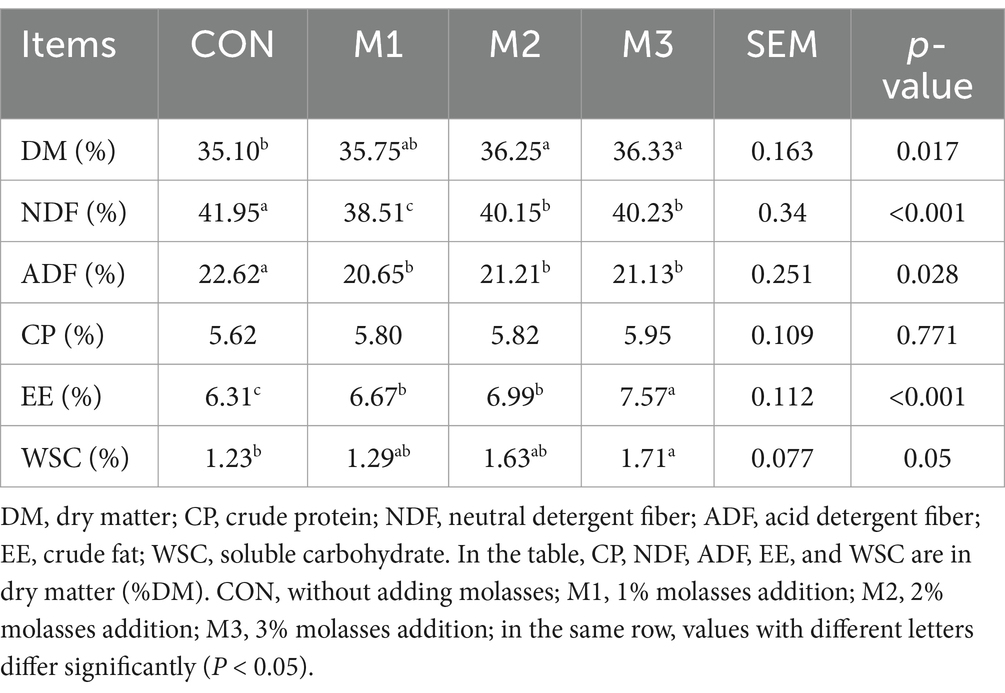
Table 3. Effect of molasses addition on the chemical composition of the ensilage mixture of seed-used zucchini peel residue and corn stalks.
As shown in Table 4, compared to the CON group, the pH values of the molasses-added groups were significantly lower, with the M3 group showing the lowest pH value of 4.30, which was significantly lower than those of the other groups (p < 0.05). There were no significant differences in lactic acid and acetic acid among all groups, and propionic acid and butyric acid were not detected. With the increase in the molasses addition level, the ratio of NH₃-N to total nitrogen showed a downward trend, and this ratio in all groups with molasses addition was lower than that in the CON group (p < 0.05). There were no significant differences in the ratio of NH₃-N to TN among the M1, M2 and M3 groups (p > 0.05).

Table 4. Effect of molasses addition on the fermentation quality of the ensilage mixture of seed-used zucchini peel residue and corn stalks.
The aerobic stability time of the M3 group was significantly lower than that of the other groups (P < 0.05), and there were no significant differences (p > 0.05) among the CON group, the M1 group and the M2 group (Figure 1).
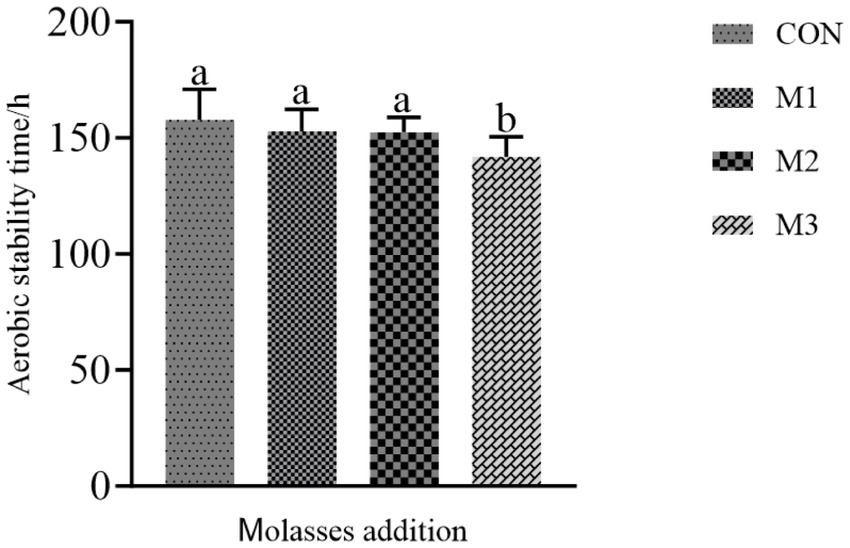
Figure 1. Effect of molasses addition on the aerobic stability of the ensilage mixture of seed-used zucchini peel residue and corn stalks. CON, without adding molasses; M1, 1% molasses addition; M2, 2% molasses addition; M3, 3% molasses addition; values with different letters differ significantly (P < 0.05).
As shown in Table 5, the aerobic exposure time had a significant impact on the pH, ammonia nitrogen and lactic acid contents in each group (p < 0.05). There was a D × T interaction between pH and lactic acid (P < 0.001). On the 0th day of aerobic exposure, the pH values of the groups with molasses addition were significantly lower than those of the CON group (p < 0.05). Among the groups with molasses addition, the lowest pH value was 4.30 in the M3 group. However, on the 9th day, the pH values of the groups with molasses addition were significantly higher than those of the CON group (p < 0.05). Among the groups with molasses addition, the highest pH value was 8.15 in the M3 group. With the extension of aerobic exposure time, the ammonia nitrogen content in each group first increased and then decreased. On the 0th day of aerobic exposure, the ammonia nitrogen decreased with the increase in the molasses addition level, and the ammonia nitrogen content in the M3 group was significantly lower than that in the CON group (p < 0.05). On the 9th day of aerobic exposure, the ammonia nitrogen in the CON and M1 groups was significantly higher than that in the M3 group (p < 0.05).
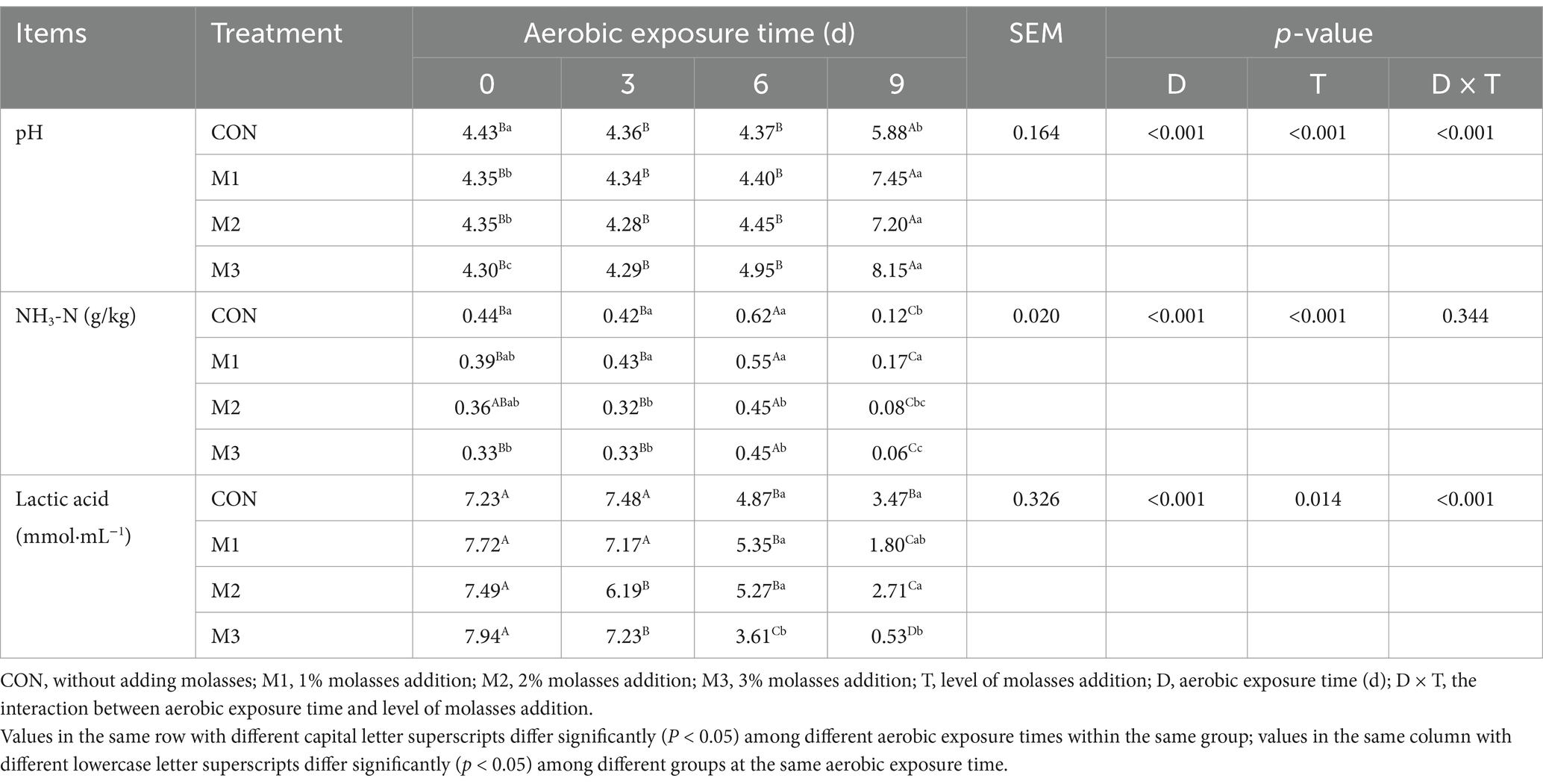
Table 5. Effect of molasses addition on the fermentation quality of the ensilage mixture of seed-used zucchini peel residue and corn stalks by the aerobic exposure.
During 0–3 days of aerobic exposure, there were no significant differences (p > 0.05) in the contents of lactic acid (Table 5) and acetic acid (Table 6) among all groups. Moreover, propionic acid and butyric acid were not detected in any of the groups (Table 6). During 6–9 days of aerobic exposure, the contents of lactic acid and acetic acid in the M3 group were significantly lower than those in the CON group (p < 0.05). There were no significant differences in the content of propionic acid among all groups (p > 0.05).
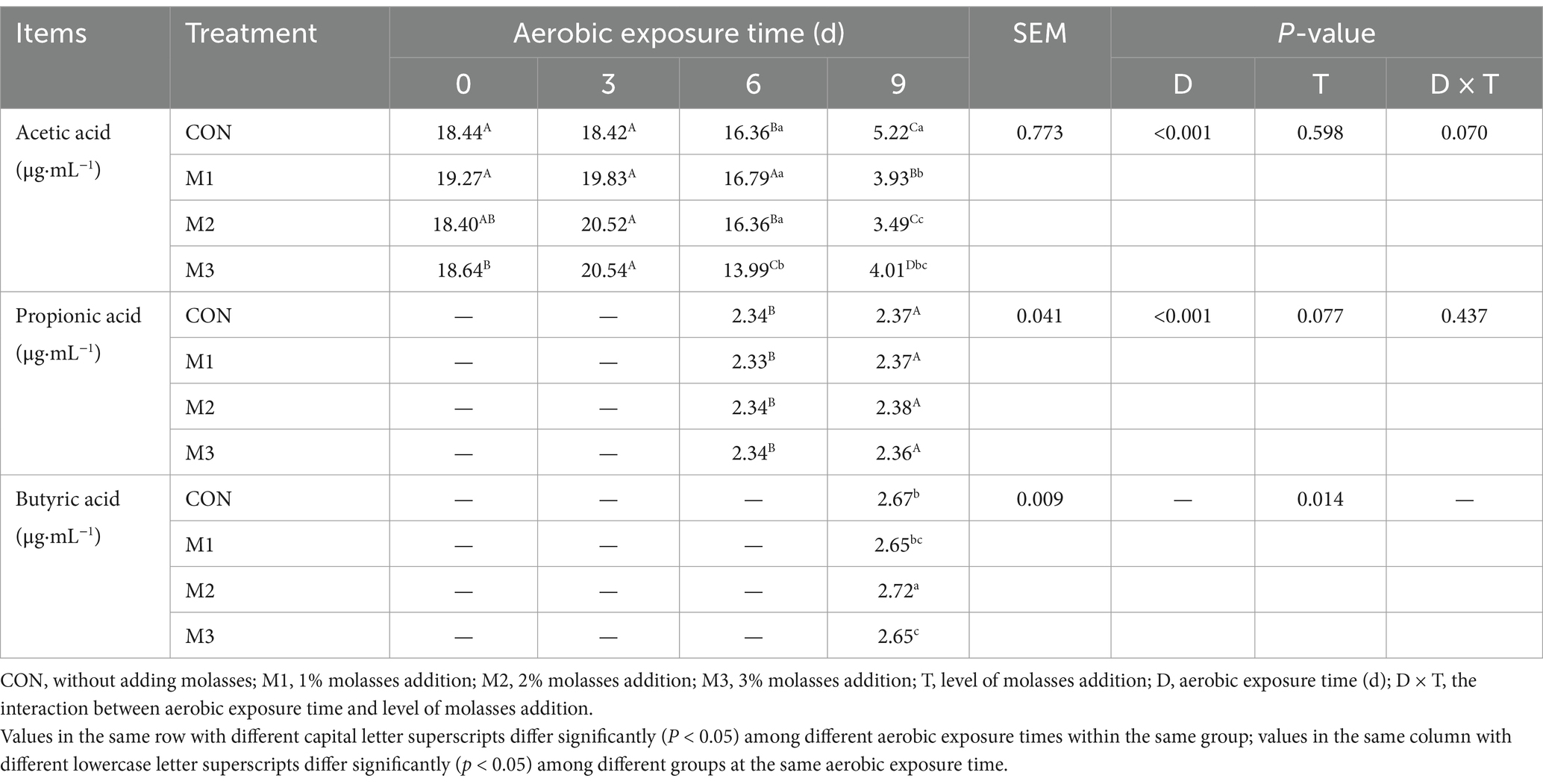
Table 6. Effect of molasses addition on volatile acids of the ensilage mixture of seed-used zucchini peel residue and corn stalks by the aerobic exposure.
As shown in Table 7, the aerobic exposure time had a significant impact on the contents of lactic acid bacteria, yeasts and molds in each group (p < 0.05). There was a D × T interaction between lactic acid bacteria and yeasts (P < 0.05). On the 0th day of aerobic exposure, the content of lactic acid bacteria in the M3 group was significantly higher than that in the other groups (p < 0.05), and molds were not detected in any of the groups. On the 9th day of aerobic exposure, both the contents of yeasts and molds in the M3 group were significantly higher than those in the other groups (p < 0.05). During the entire aerobic exposure period, the M3 group exhibited the largest decrease in lactic acid bacteria, with a reduction of 0.87 lg (CFU/g FM), while the CON group showed the smallest decrease, with a reduction of 0.50 lg (CFU/g FM).
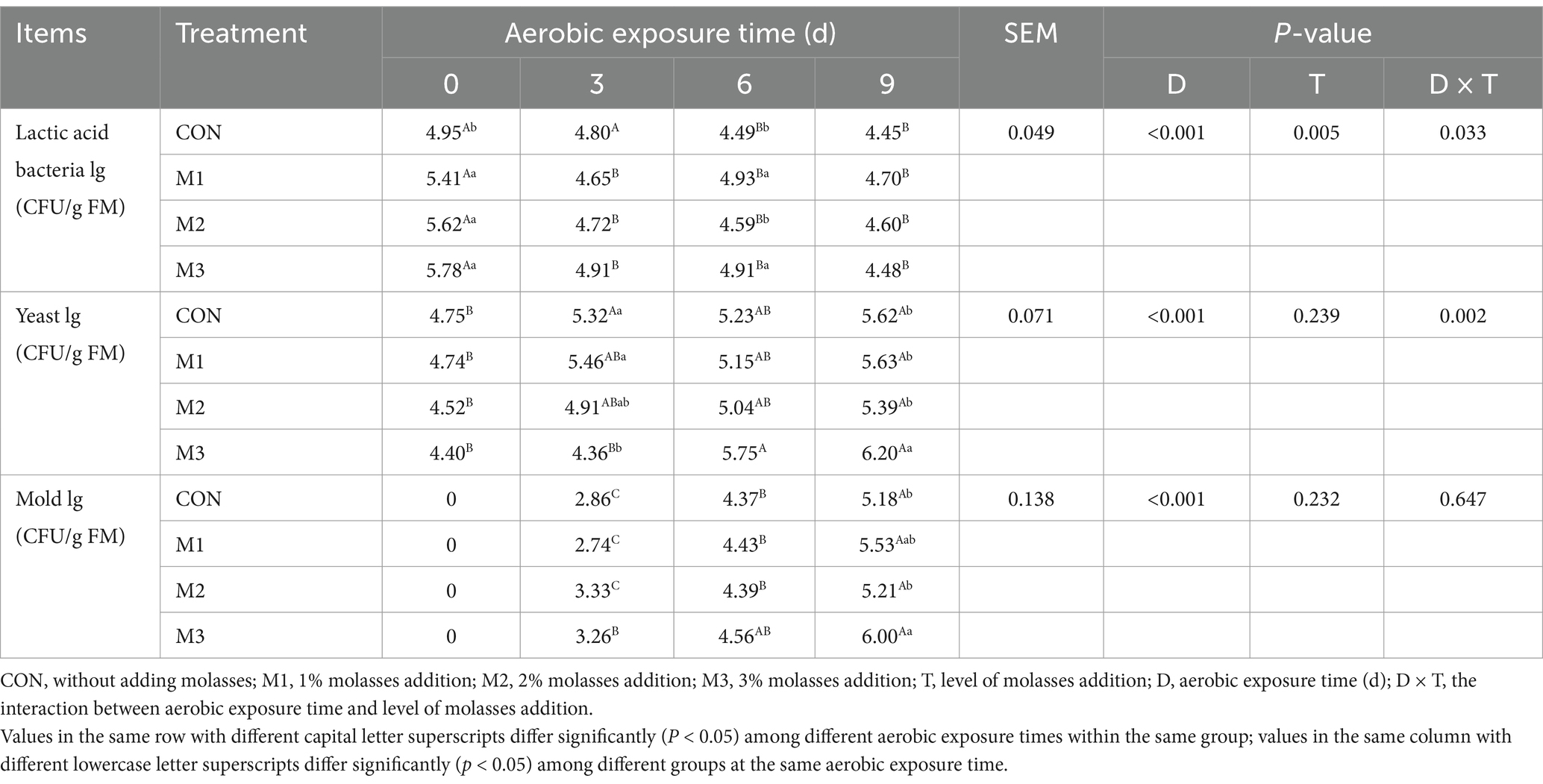
Table 7. Effect of molasses addition on the silage quantity of the ensilage mixture of seed-used zucchini peel residue and corn stalks by the aerobic exposure.
As shown in Table 8, with the increase in the amount of molasses added, the degradation rates of DM in each group generally showed an upward trend. Except at 4 h, at the other time points, the ruminal degradation rates of DM in the M2 and M3 groups were significantly higher than those in the M1 and CON groups (p < 0.05). After 24 h, the degradation rates of DM in the groups with molasses addition were all significantly higher than those in the CON group (p < 0.05). In the rapidly degradable fraction, the M3 and CON groups were significantly higher than the M1 and M2 groups; while in the slowly degradable fraction, the M1 and M2 groups were significantly higher than the M3 and CON groups (p < 0.05). The effective degradation rate of DM in the M2 and M3 groups was significantly higher than that in the other two groups (p < 0.05), while the M1 group was significantly higher than the CON group (p < 0.05). Compared to the CON group, the effective degradation rates of DM increased by 3.20, 7.06, and 6.71 percentage points, respectively.
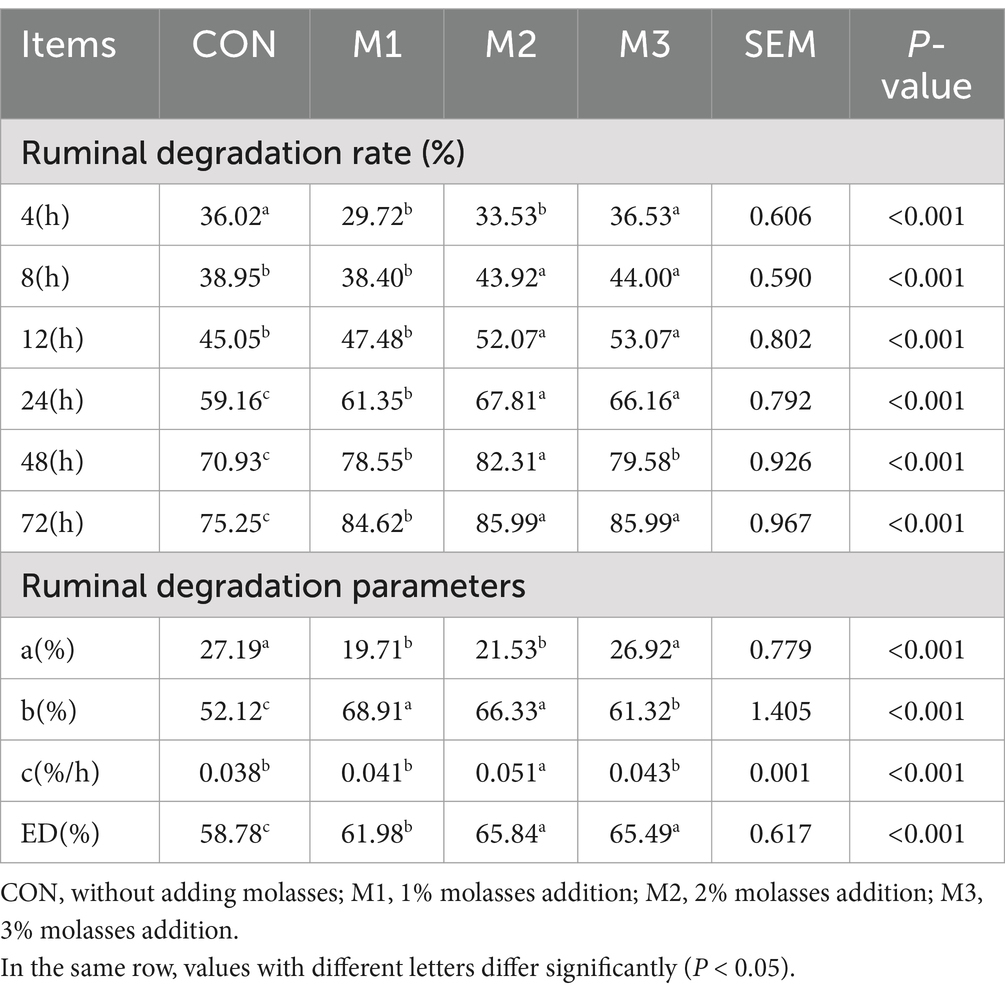
Table 8. Effect of molasses addition on the ruminal dry matter degradation of the ensilage mixture of seed-used zucchini peel residue and corn stalks.
At the six time points, the ruminal degradation rates of CP in the groups with molasses addition were all higher than those in the CON group, and the ruminal degradation rate of the M3 group was the highest (Table 9), with the degradation rate ranging from 37.06 to 76.05%. The rapidly degradable fraction and the effective degradation rate in the groups with molasses addition were both significantly improved compared with those in the CON group (p < 0.05). Moreover, the effective degradation rate of CP in the M3 group was the highest among all groups (p < 0.05). However, there were no significant differences in the slowly degradable fraction among all groups (p > 0.05).
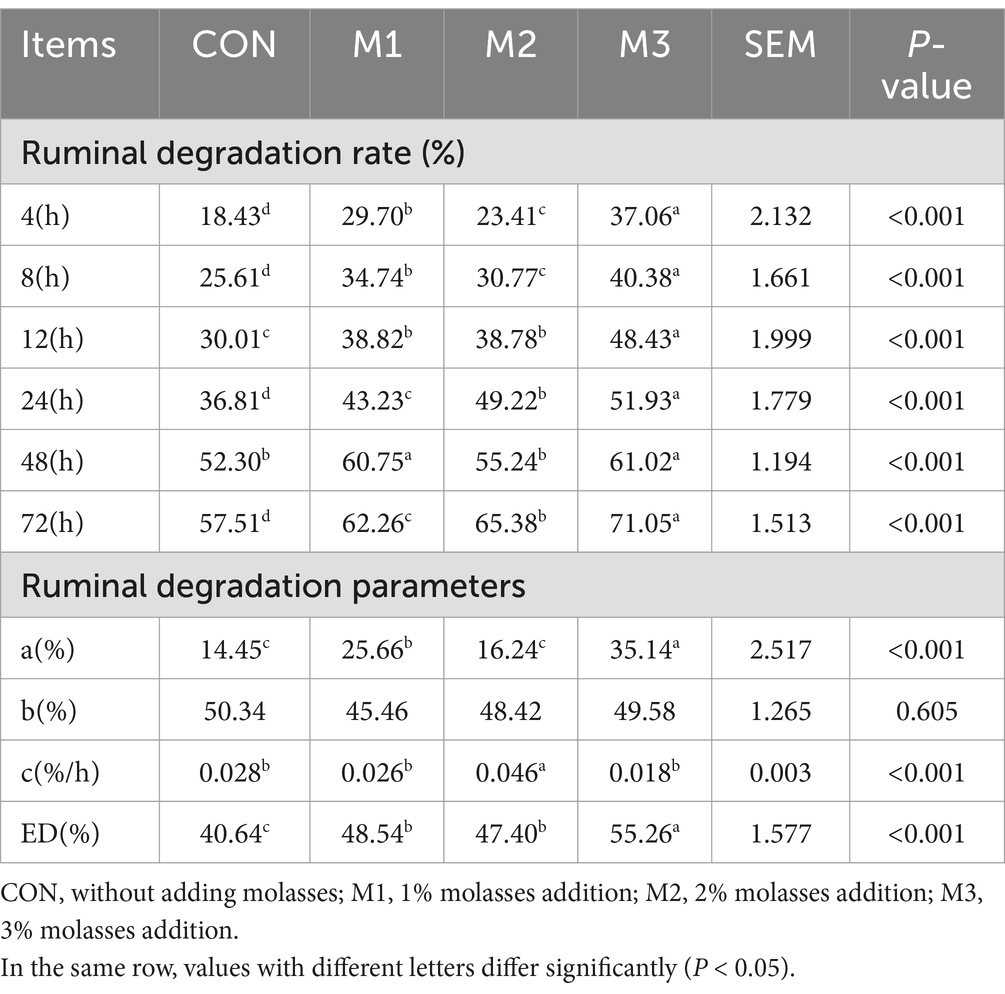
Table 9. Effect of molasses addition on the ruminal crude protein degradation of the ensilage mixture of seed-used zucchini peel residue and corn stalks.
As shown in Table 10, at 48 h, the ruminal degradation rate of NDF in the M1 group was the highest (p < 0.05). By 72 h, the ruminal degradation rates of NDF in the groups with molasses addition were all significantly higher than that in the CON group (p < 0.05). With the addition of molasses, the rapidly degradable fraction, the slowly degradable fraction and the effective degradation rate were all higher than those in the CON group. Among them, the effective degradation rate of NDF in the CON group was significantly lower than that in the groups with molasses addition (p < 0.05).
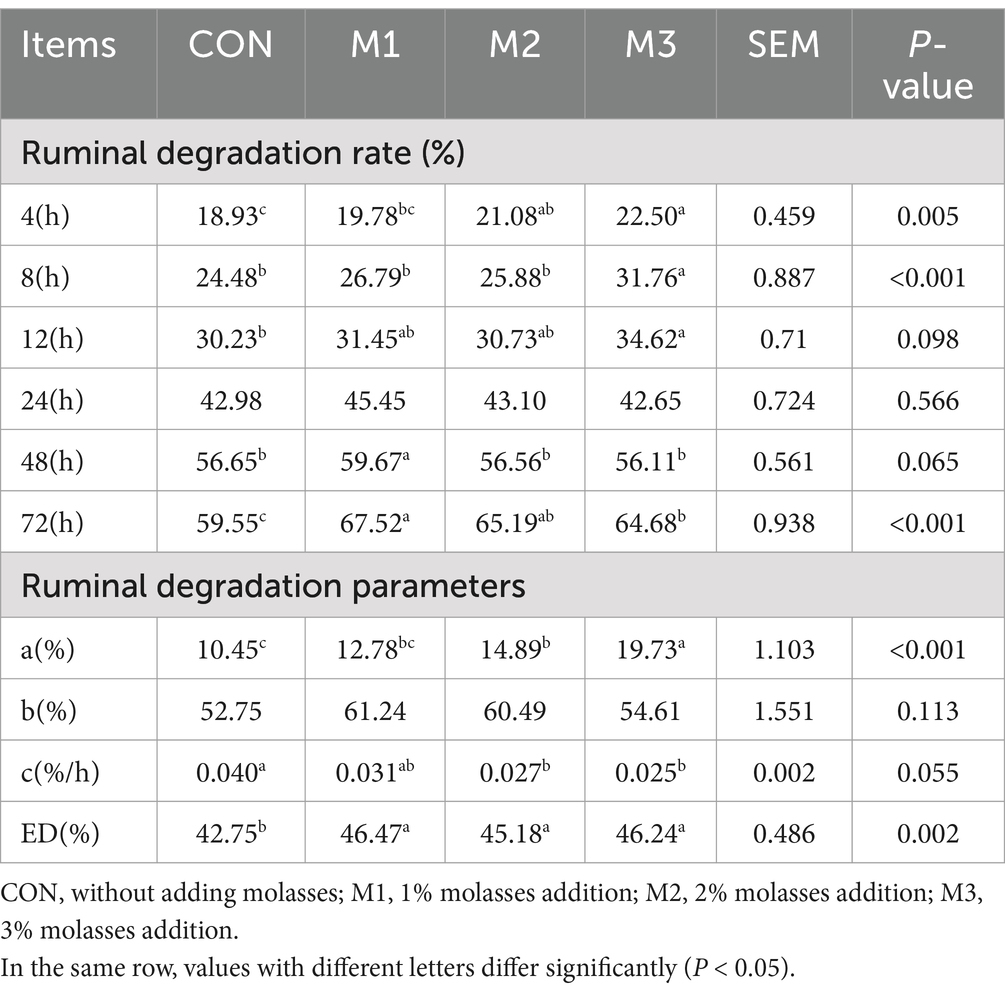
Table 10. Effect of molasses addition on the ruminal neutral detergent fiber degradation of the ensilage mixture of seed-used zucchini peel residue and corn stalks.
The change trend of the ruminal degradation rate of ADF was consistent with that of NDF. At 48 h, the ruminal degradation rate of ADF in the M1 group was the highest, and the difference was significant (p < 0.05). By 72 h, the ruminal degradation rates of ADF in the groups with molasses addition were all significantly higher than those in the CON group (p < 0.05). With the addition of molasses, both the rapidly degradable fraction and the effective degradation rate were higher than those in the CON group. In the CON group, the effective degradation rate of ADF was significantly lower than that in the groups with molasses addition (p < 0.05). Compared to the CON group, the effective degradation rates of ADF in the M1, M2, and M3 groups increased by 3.05, 3.02, and 4.8 percentage points, respectively (Table 11).
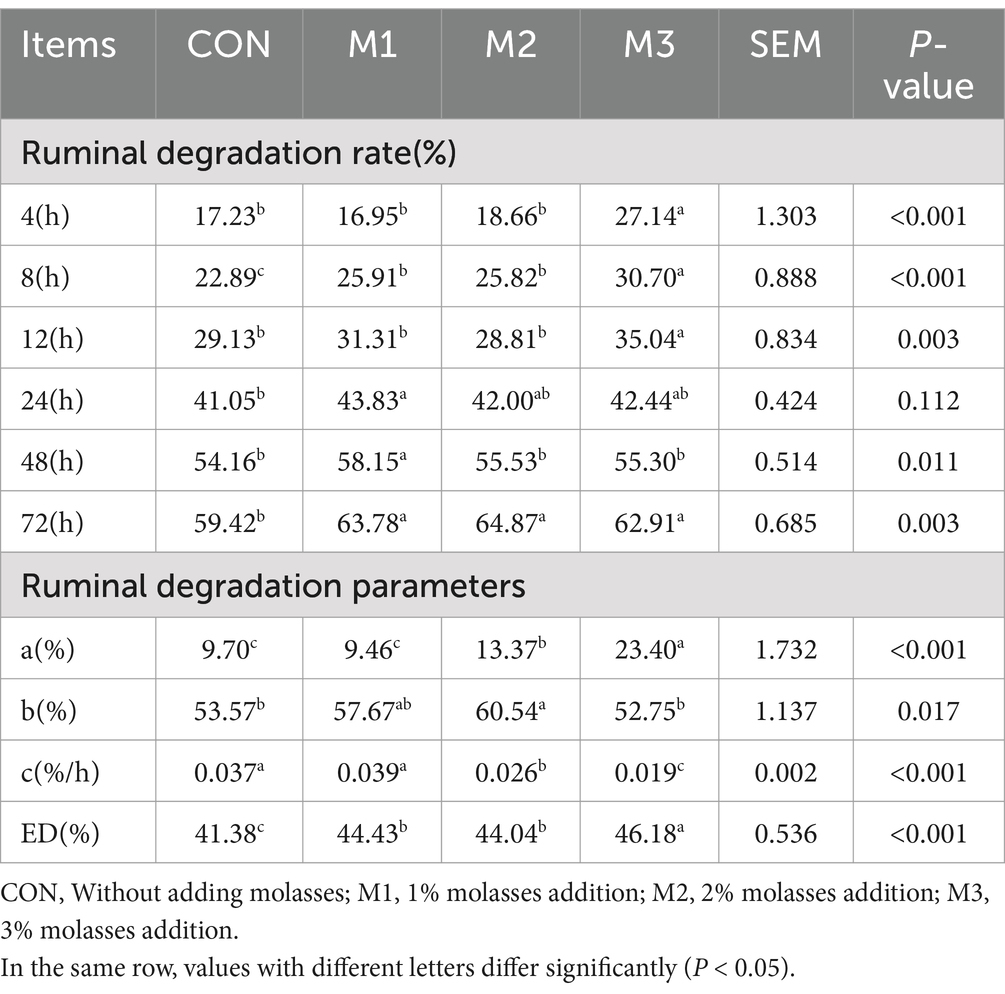
Table 11. Effect of molasses addition on the ruminal acid detergent fiber degradation of the ensilage mixture of seed-used zucchini peel residue and corn stalks.
Sufficient moisture content can enhance the quality of silage, while the amounts of DM and WSC serve as important indicators of this quality. This study aimed to enhance the moisture content of corn stalks by incorporating seed-used zucchini peel residue, thereby creating optimal conditions for ensilage process. However, previous studies indicated that both seed-used zucchini and corn stalks possess low sugar content, which may hinder the ability to maintain high-quality silage (Liu et al., 2023; Wang et al., 2024). To address this issue, we supplemented the mixture with varying amounts of molasses to increase WSC levels. After 60 days of silage with added molasses, the DM and CP contents were found to be higher than those in the no-molasses control group, which was consistent with the findings of Li et al. (2022), who reported similar results when molasses was added to fresh forage. In this experiment, the groups with molasses addition significantly reduced the NDF and ADF contents in silage. The reduction may be attributed to the fact that molasses provided a richer carbon source for microorganisms, thereby promoting the growth and reproduction of cellulolytic bacteria and accelerating the catabolic process of fiber (Qutab-ud-din and Macit, 2020). Lower fiber content improves the digestibility of feed in animals, particularly for ruminants, by improving rumen fermentation and promoting the nutrient absorption and utilization, thus increasing the feed’s nutritional value. Clearly, the peel residue of seed-used zucchini supplied necessary moisture for the corn stalks, facilitating the fermentation process, while molasses provided sufficient WSC and improved the nutritional composition of the feed.
The results of this study demonstrate that the addition of molasses significantly increased the population of lactic acid bacteria (LAB) in silage. This finding is consistent with previous studies, which have shown that molasses serves as an effective microbial stimulant, promoting the growth of beneficial microorganisms such as LAB (Lukkananukool et al., 2019). The increased LAB population likely contributed to the improved fermentation quality observed in the molasses-added group, as LAB play a crucial role in reducing pH and inhibiting the growth of undesirable microorganisms. In this experiment, the higher lactic acid content and lower pH values in the M3 group can be attributed to the increased activity of LAB. This is consistent with the highest number of LAB observed in the M3 group, suggesting that molasses at this concentration provided an optimal environment for LAB proliferation. During the fermentation process, microorganisms utilize these carbohydrates for their growth and metabolic activities, generating a large amount of organic acids and thus reducing the pH value of the silage (Luo et al., 2021). Previous studies have shown that adding molasses to silage resulted in a lower pH value and a higher lactic acid content (Li et al., 2017), which aligns with our findings. A lower pH inhibits the growth of acid-sensitive microorganisms, thus reducing nutrient losses.
In our experiment, propionic acid and butyric acid were not detected in any of the treatment groups. This absence may be because the lactic acid produced through the proliferation of lactic acid bacteria inhibited the growth of harmful microorganisms, thereby lowering the butyric acid production and nutrient loss. This observation is consistent with the higher dry matter content noted in the groups with added molasses. Some studies have found that reducing pH can help inhibit protein hydrolysis, thus preserving protein (Luo et al., 2021). The ratio of NH3-N to TN serves as an indicator of protein degradation in silage; higher values indicate greater protein breakdown and poorer feed quality (Xia et al., 2017). In previous studies involving mixed silage of amaranth and corn stover, glucose addition was found to reduce the NH3-N/TN ratio compared to the control group (Ma et al., 2023). In this experiment, the NH3-N/TN ratio in the molasses-added groups was lower than that in the control group, confirming the inhibition of protein hydrolysis activities (Mordenti et al., 2021). The addition of molasses promotes anaerobic fermentation, increases the percentage of lactic acid, reduces pH and ammonia nitrogen content, thereby inhibiting protein hydrolysis, better preserving the nutritional components of the silage, and improving feed quality.
Aerobic stability is an important indicator for assessing whether silage has deteriorated (Carvalho et al., 2015), and presents a significant challenge for farmers utilizing silage (Muck, 2004). Spoiled feed not only diminishes nutritional value but can also pose serious health risks to livestock (Wambacq et al., 2013). The increase in temperature and pH during aerobic exposure is primarily driven by the activity of aerobic microorganisms, such as yeasts and molds, which utilize water-soluble carbohydrates (WSC) and lactic acid as energy sources (Johnson et al., 2002). Temperature change is widely used to assess aerobic stability (Shan et al., 2021). In our study, the CON group exhibited the highest aerobic stability, likely due to its lower WSC and lactic acid content, which limited the growth of aerobic microorganisms. Conversely, the molasses-added groups, particularly M3, showed reduced aerobic stability, consistent with their higher WSC and lactic acid levels. This aligns with previous findings that adding fermentable carbohydrates, such as glucose or molasses, can enhance initial fermentation but reduce aerobic stability (Dong et al., 2020). During aerobic exposure, higher amounts of molds and yeasts in the M3 group compared to other treatments were likely due to its greater WSC and lactic acid content. This suggests that abundant nutrients create a favorable environment for aerobic microorganisms, promoting their growth and reproduction (Mu et al., 2021; Qiu et al., 2024).
During aerobic exposure, the decline in lactic acid and acetic acid content, coupled with the increase in propionic acid and butyric acid, reflects the metabolic shift from anaerobic to aerobic conditions. Lactic acid, a key product of anaerobic fermentation, is rapidly consumed by aerobic microorganisms, leading to a rise in pH and the proliferation of spoilage bacteria (Liu et al., 2024). The production of butyric acid, which has a strong odor, is particularly concerning as it can reduce feed palatability and intake, ultimately affecting animal performance (Wambacq et al., 2013). The ammonia nitrogen content of all treatments showed an increasing trend from 0 to 6 days, which might be due to the fact that during the aerobic exposure stage, aerobic microorganisms used the fermentation substrate to degrade crude protein in the silage into ammonia nitrogen (Chen et al., 2014). However, in the later stage of aerobic exposure, the ammonia nitrogen content decreased, which might be attributed to the utilization of ammonia nitrogen by some aerobic microorganisms under aerobic conditions, as well as potential losses due to volatilization. The reduction in aerobic stability negatively impacts the preservation and utilization of silage. To address this issue, molasses can be used in combination with other additives to effectively enhance the aerobic stability of the feed. Research has shown that the addition of both molasses and Lactobacillus plantarum in silage significantly improves aerobic stability compared to using molasses alone (Mu et al., 2021). Furthermore, adding propionic acid to molasses-based silage also markedly enhances the aerobic stability of the feed (Chen et al., 2016). These methods provide viable solutions for improving the preservation performance of silage.
Adding molasses during the silage phase may enhance feed utilization (Douglas et al., 2019). In this experiment, the increased degradation rates of DM and CP served as clear evidence. Both are important indicators for evaluating the nutritional value of feed. The dry matter degradation characteristics reflect the overall energy supply of the feed, which is significantly influenced by the fiber content and structure in the feed. On the other hand, the ruminal crude protein degradation characteristics reflect the efficiency of protein utilization, with its degradation rate being closely related to the structure and composition of the protein in the feed. The increase in both can be attributed to the high content of WSC in molasses, which serve as an easily fermentable energy source for ruminal microorganisms. Enhanced microbial activity not only accelerates the breakdown of DM and CP but also promotes the production of volatile fatty acids (VFAs), which are crucial for energy supply in ruminants. In our study, the DM degradation rates in the molasses-added groups (M2 and M3) were significantly higher than those in the CON, particularly after 24 h of incubation. This is roughly in line with previous research. They used a 4% molasses addition, which significantly increased the ruminal degradation rate of dry matter in rice straw silage (Zhao et al., 2019). These findings underscore the role of molasses in enhancing feed digestibility and nutrient availability. Research indicates that silage made from mixture of seed-used zucchini peel residue and corn stalks possesses significant nutritional advantages. Compared to other treatment methods, this feed demonstrates a higher nutrient degradation rate. Specific data show that corn silage supplemented with oregano essential oil and organic cobalt has a DM rumen degradation rate of 55.88–56.60% at 48 h (Li et al., 2021). In contrast, corn stover silage with added defective fragrant pears exhibits a DM degradation rate ranging from 45 to 55% (Guo et al., 2024). Furthermore, when lactic acid bacteria, glucose, and cellulase are introduced into silage made from amaranth and corn stover, the 72 h DM rumen degradation rate reaches 64–71.9% (Ma et al., 2023). Notably, the 72 h DM degradation rate of the silage made from seed-used zucchini peel residue and corn stover in this study is as high as 75–85%. This result not only significantly surpasses other treatment methods but also highlights the immense potential of seed-used zucchini peel residue as a high-quality feed ingredient.
In our experiment, at all-time points, the ruminal degradation rate of CP in the molasses-added groups was higher than that in the control group, with the M3 group exhibiting the highest effective degradation rate. This observation is consistent with the finding that the M3 group had the highest CP content and corroborates previous research (Anggraeni et al., 2024). However, unlike previous studies that focused on a single forage substrate, our study investigated the mixed ensilage of seed-used zucchini peel residue and corn stalks. This combination not only provided a unique substrate for microbial activity but also highlighted the synergistic effects of molasses and agricultural by-products on feed quality. The higher CP degradation rates observed in the molasses-added groups, particularly in the M3 group, further support the notion that molasses can optimize nutrient utilization in ruminants.
For ruminants, the rumen is crucial for nutrient digestion, particularly fiber digestion (Liu et al., 2019). The unique microbial ecosystem in the rumen produces cellulolytic and ligninolytic enzymes that effectively decompose and transform fiber components in feed, providing ruminants with the energy and other essential nutrients needed for life and production activities, making it integral to their overall metabolism (Xing et al., 2020). In this experiment, the ruminal degradation rates and effective degradation rates of neutral detergent fiber and acid detergent fiber at 72 h in the groups with added molasses were higher than those in the control group. This may relate to the preference of fiber-decomposing microorganisms for the soluble sugars found in molasses (Fondevila et al., 1994). Molasses supplies carbohydrates for rapid fermentation, and cellulolytic bacteria initially convert carbohydrates into glucose, which is subsequently fermented to yield methane, carbon dioxide, water, and volatile fatty acids, ultimately increasing cellulose digestibility (Ciriaco et al., 2015; Izquierdo et al., 2021).
In conclusion, our findings highlight the potential of molasses as a valuable additive for improving silage quality. By promoting the growth of LAB and enhancing fermentation, molasses could contribute to more efficient and sustainable silage production practices. Despite these insights, our study has some limitations. For instance, we did not measure the total bacterial count or analyze the microbial community composition, which could have provided a more comprehensive understanding of the microbial dynamics in silage. Furthermore, the experiment was conducted under controlled conditions; field studies are needed to validate the feed utilization in actual feeding scenarios. Future research should explore the long-term effects of this silage feed on animal performance, as well as the potential of combining molasses with other feed additives to further enhance nutrient utilization and feed efficiency. We believe that in the future, a technical service platform could be established to encourage collaboration between feed enterprises and farmers. Additionally, further research should focus on developing high-value-added products to improve the market competitiveness of agricultural waste such as seed-used zucchini peel residue.
This study demonstrated that the addition of molasses effectively addressed the quality issues of ensilage mixture comprising seed-used zucchini peel residue and corn stalks. Compared to the CON group, the addition of molasses significantly reduced the pH and the ratio of ammonia nitrogen to total nitrogen (NH3-N/TN) in the ensilage mixture of seed-used zucchini peel residue and corn stalks. In the groups with molasses added, the pH values decreased by 0.08, 0.09, and 0.13, respectively, compared to the control group. The ratio of NH3-N/TN decreased by 1.52, 1.86, and 2.24, respectively, compared to the control group. Notably, the feed with 3% molasses exhibited the most significant improvements. The aerobic stability of the silage feed in this study was relatively good, allowing preservation for about 6 days. However, in practical production, it is recommended to fully utilize the feed within 2–3 days. In conclusion, based on the fermentation quality and ruminal degradation rates, we can confirm that molasses has effectively improved the fermentation quality and utilization efficiency of the ensilage mixture containing the seed-used zucchini peel residue and corn stalks. In the future, we will further investigate the microbial community succession during the ensilaging process of seed-used zucchini and corn stalks, exploring the correlation between microorganisms and feed quality.
The original contributions presented in the study are included in the article/supplementary material, further inquiries can be directed to the corresponding authors.
The animal study was reviewed and approved by the Bioethics Committee of Shihezi University (Shihezi, Xinjiang, China). The study was conducted in accordance with the local legislation and institutional requirements.
TW: Data curation, Writing – review & editing, Formal analysis, Investigation, Methodology, Resources, Software, Writing – original draft. ZH: Data curation, Writing – review & editing, Project administration. NZ: Conceptualization, Data curation, Investigation, Writing – review & editing. KK: Data curation, Formal analysis, Methodology, Writing – review & editing. XS: Data curation, Project administration, Supervision, Writing – review & editing. CS: Data curation, Formal analysis, Methodology, Writing – review & editing. DH: Data curation, Methodology, Supervision, Writing – review & editing. XW: Data curation, Funding acquisition, Project administration, Writing – review & editing.
The author(s) declare financial support was received for the research and/or publication of this article. This work was financially supported by the Xinjiang Production and Construction Corps. Key Areas of Technological Research and Development (2023AB008), the 8th Group Key Areas of Technological Research and Development (2023NY03) and the Scientific Research Project of Shihezi University (KJTP202316) and Xinjiang Production and Construction Corps Agricultural Key Projects.
The authors declare that the research was conducted in the absence of any commercial or financial relationships that could be construed as a potential conflict of interest.
The authors declare that no Gen AI was used in the creation of this manuscript.
All claims expressed in this article are solely those of the authors and do not necessarily represent those of their affiliated organizations, or those of the publisher, the editors and the reviewers. Any product that may be evaluated in this article, or claim that may be made by its manufacturer, is not guaranteed or endorsed by the publisher.
Anggraeni, A. S., Jayanegara, A., Sofyan, A., Laconi, E. B., Kumalasari, N. R., Gunadarma, I. N., et al. (2024). In vitro and in sacco evaluation of total mixed ration silage added different levels of chitosan. Czeh J. Anim. Sci. 69, 178–190. doi: 10.17221/173/2023-CJAS
AOAC International (2019). Official methods of analysis of AOAC international. 21st Edn. Washington, DC: AOAC International.
Broderick, G. A., and Kang, J. H. (1980). Automated simultaneous determination of Ammonia and Total amino acids in ruminal fluid and in vitro Media1. J. Dairy Sci. 63, 64–75. doi: 10.3168/jds.S0022-0302(80)82888-8
Carvalho, B. F., Ávila, C. L. S., Miguel, M. G. C. P., Pinto, J. C., Santos, M. C., and Schwan, R. F. (2015). Aerobic stability of sugar-cane silage inoculated with tropical strains of lactic acid bacteria. Grass Forage Sci. 70, 308–323. doi: 10.1111/gfs.12117
Chen, L., Guo, G., Yuan, X., Shimojo, M., Yu, C., and Shao, T. (2014). Effect of applying molasses and propionic acid on fermentation quality and aerobic stability of Total mixed ration silage prepared with whole-plant corn in Tibet. Asian Australas. J. Anim. Sci. 27, 349–356. doi: 10.5713/ajas.2013.13378
Chen, L., Guo, G., Yuan, X., Zhang, J., Li, J., and Shao, T. (2016). Effects of applying molasses, lactic acid bacteria and propionic acid on fermentation quality, aerobic stability and in vitro gas production of total mixed ration silage prepared with oat-common vetch intercrop on the Tibetan plateau. J. Sci. Food Agric. 96, 1678–1685. doi: 10.1002/jsfa.7271
Ciriaco, F. M., Henry, D. D., Mercadante, V. R. G., Schulmeister, T., Ruiz-Moreno, M., Lamb, G. C., et al. (2015). Effects of different levels of supplementation of a 50:50 mixture of molasses: crude glycerol on performance, Bermuda grass hay intake, and nutrient digestibility of beef cattle. J. Anim. Sci. 93, 2428–2438. doi: 10.2527/jas.2015-8888
Dong, Z., Wang, S., Zhao, J., Li, J., and Shao, T. (2020). Effects of additives on the fermentation quality, in vitro digestibility and aerobic stability of mulberry (Morus alba L.) leaves silage. Asian Australas. J. Anim. Sci. 33, 1292–1300. doi: 10.5713/ajas.19.0420
Douglas, N. B., Meeske, R., Muya, M. C., Langa, T., Thomas, R. S., Malebana, I. M. M., et al. (2019). Microbial additives affect silage quality and ruminal dry matter degradability of avocado (Persia Americana) pulp silage. South Afr. J. Anim. Sci. 49, 997–1007. doi: 10.4314/sajas.v49i6.3
Fondevila, M., Castrillo, C., Guada, J. A., and Balcells, J. (1994). Effect of ammonia treatment and carbohydrate supplementation of barley straw on rumen liquid characteristics and substrate degradation by sheep. Anim. Feed Sci. Technol. 50, 137–155. doi: 10.1016/0377-8401(94)90015-9
Fu, Y., Zhang, J., and Guan, T. (2023). High-value utilization of corn straw: from waste to wealth. Sustain. For. 15:14618. doi: 10.3390/su151914618
Guo, R., Chen, Y., Zhou, H., Jiang, T., Wang, D., Jiang, H., et al. (2024). Effect of Adding Defective Pear Fermentated Substance on the Corn Stalks Silage In Vitro Fermentation. Journal of Domestic Animal Ecology. 45, 28–32. doi: 10.3969/j.issn.1673-1182.2024.08.005
Hou, L., Guo, T., Zhang, J., Su, L., Guzalnur, A., Wen, X., et al. (2023). Effect evaluation of mixed storage of different proportions of seed pumpkin waste and corn straw. Xinjiang Agric. Sci. 3, 567–573. doi: 10.6048/j.issn.1001-4330.2023.03.006
Izquierdo, A. C., Reyes, A. E. I., Lang, G. R., Oaxaca, J. S., Liera, J. E. G., Mancera, E. A. V., et al. (2021). Nutrition and food in the reproduction of cattle. Eur. J. Agric. Food Sci. 3, 21–33. doi: 10.24018/ejfood.2021.3.3.184
Johnson, L. M., Harrison, J. H., Davidson, D., Mahanna, W. C., Shinners, K., and Linder, D. (2002). Corn silage management: effects of maturity, inoculation, and mechanical processing on pack density and aerobic stability. J. Dairy Sci. 85, 434–444. doi: 10.3168/jds.S0022-0302(02)74092-7
Li, Y., Du, S., Sun, L., Cheng, Q., Hao, J., Lu, Q., et al. (2022). Effects of lactic acid Bacteria and molasses additives on dynamic fermentation quality and microbial Community of Native Grass Silage. Front. Microbiol. 13:830121. doi: 10.3389/fmicb.2022.830121
Li, X., Jiao, T., Zhao, S., Qin, W., Gao, X., Wu, J., et al. (2021). Synergistic effect of oregano essential oil and organic cobalt on degradation characteristics of silage maize stalks and rumen fermentation of sheep. Acta Pratacul. Sin. 30, 191–202. doi: 10.11686/cyxb2020414
Li, L., Yuan, Z., Sun, Y., Kong, X., Dong, P., and Zhang, J. (2017). A reused method for molasses-processed wastewater: effect on silage quality and anaerobic digestion performance of Pennisetum purpureum. Bioresour. Technol. 241, 1003–1011. doi: 10.1016/j.biortech.2017.04.117
Liu, H., Li, X., Yang, F., Hu, J., Jia, Y., and Shao, T. (2024). Effects of ensiling density on the fermentation profile and aerobic stability of wilted alfalfa silage. Agronomy 14:1143. doi: 10.3390/agronomy14061143
Liu, J., Wang, S., Sun, W., Zang, C., Yang, K., Chen, Y., et al. (2023). Effects of mixed silage of deseeded parts of zucchini and seeding-watermelon with wheat straw on fermentation quality, nutritional composition, and rumen degradation rate. J. Xinjiang Agric. Univ. 46, 87–93. doi: 10.20088/j.cnki.jxau.2023.02.001
Liu, K., Wang, L., Yan, T., Wang, Z., Xue, B., and Peng, Q. (2019). Relationship between the structure and composition of rumen microorganisms and the digestibility of neutral detergent fibre in goats. Asian Australas. J. Anim. Sci. 32, 82–91. doi: 10.5713/ajas.18.0043
Lukkananukool, A., Srikijkasemwat, K., Promnaret, A., Aung, M., Santos, M. C., and Kyawt, Y. Y. (2019). Fermented Juice of Epiphytic Lactic Acid Bacteria and Molasses Addition on the Fermentation Characteristics and Nutrient Compositions of Sorghum Silage. Adv. Anim. Vet. Sci. 7. doi: 10.17582/journal.aavs/2019/7.8.668.673
Luo, R., Zhang, Y., Wang, F., Liu, K., Huang, G., Zheng, N., et al. (2021). Effects of sugar cane molasses addition on the fermentation quality, microbial community, and tastes of alfalfa silage. Animals 11:355. doi: 10.3390/ani11020355
Ma, J., Fan, X., Ma, Z., Huang, X., Tang, M., Yin, F., et al. (2023). Silage additives improve fermentation quality, aerobic stability and rumen degradation in mixed silage composed of amaranth and corn straw. Front. Plant Sci. 14:9747. doi: 10.3389/fpls.2023.1189747
Mordenti, A. L., Giaretta, E., Campidonico, L., Parazza, P., and Formigoni, A. (2021). A review regarding the use of molasses in animal nutrition. Animals 11:115. doi: 10.3390/ani11010115
Mu, L., Xie, Z., Hu, L., Chen, G., and Zhang, Z. (2021). Lactobacillus plantarum and molasses alter dynamic chemical composition, microbial community, and aerobic stability of mixed (amaranth and rice straw) silage. J. Sci. Food Agric. 101, 5225–5235. doi: 10.1002/jsfa.11171
Muck, R. E. (2004). Effects of corn silage inoculants on aerobic stability. Trans. ASAE 47, 1011–1016. doi: 10.13031/2013.16571
Ørskov, E. R., and McDonald, I. (1979). The estimation of protein degradability in the rumen from incubation measurements weighted according to rate of passage. J. Agric. Sci. 92, 499–503. doi: 10.1017/S0021859600063048
Palmonari, A., Cavallini, D., Sniffen, C. J., Fernandes, L., Holder, P., Fagioli, L., et al. (2020). Short communication: characterization of molasses chemical composition. J. Dairy Sci. 103, 6244–6249. doi: 10.3168/jds.2019-17644
Qiu, C., Yang, K., Diao, X., Zhang, W., Lv, R., and He, L. (2024). Effects of kinds of additives on fermentation quality, nutrient content, aerobic stability, and microbial community of the mixed silage of king grass and rice straw. Front. Microbiol. 15:1420022. doi: 10.3389/fmicb.2024.1420022
Qutab-ud-din, H. G., and Macit, M. (2020). Effects of silage effluent, urea-molasses and water treatment on in situ rumen degradation and microbiological traits of wheat straw. J. Anim. Plant Sci. 30, 576–585. doi: 10.36899/JAPS.2020.3.0068
Shan, G., Maack, C., Buescher, W., Glenz, G., Milimonka, A., Deeken, H., et al. (2021). Multi-sensor measurement of O2, CO2 and reheating in triticale silage: an extended approach from aerobic stability to aerobic microbial respiration. Biosyst. Eng. 207, 1–11. doi: 10.1016/j.biosystemseng.2021.04.004
Shi, M. J., Ma, Z. X., Tian, Y. J., Ma, C., Li, Y. D., and Zhang, X. W. (2022). Effects of corn straw treated with CaO on rumen degradation characteristics and fermentation parameters and their correlation with microbial diversity in rumen. Anim. Feed Sci. Technol. 292:115403. doi: 10.1016/j.anifeedsci.2022.115403
Van Soest, P. J., Robertson, J. B., and Lewis, B. A. (1991). Methods for dietary Fiber, neutral detergent Fiber, and non-starch polysaccharides in relation to animal nutrition. J. Dairy Sci. 74, 3583–3597. doi: 10.3168/jds.S0022-0302(91)78551-2
Wambacq, E., Latré, J. P., and Haesaert, G. (2013). The effect of Lactobacillus buchneri inoculation on the aerobic stability and fermentation characteristics of alfalfa-ryegrass, red clover and maize silage. Agric. Food Sci. 22, 127–136. doi: 10.23986/afsci.6711
Wang, L. L., Li, Y. F., Wu, L. Z., Yu, Y. S., Panyavong, X., and Kim, J. G. (2024). Effects of fruit and vegetable waste addition on corn stalk silage quality. Anim Biosci 37, 1595–1602. doi: 10.5713/ab.24.0106
Wang, X., Zhu, Z., Sun, X., Xiang, C., Huang, Z., and Zhang, L. (2020). Evaluation of the nutritional value of the microbial storage mixture of seed-used gourd and wheat straw. Anim. Breed. Feed 2, 15–17. doi: 10.13300/j.cnki.cn42-1648/s.2020.02.004
Xia, C., Liang, Y., Bai, S., He, Y., Muhammad, A. U. R., Su, H., et al. (2017). Effects of harvest time and added molasses on nutritional content, ensiling characteristics and in vitro degradation of whole crop wheat. Asian Australas. J. Anim. Sci. 31, 354–362. doi: 10.5713/ajas.17.0542
Xie, Y., Wang, L., Li, W., Xu, S., Bao, J., Deng, J., et al. (2022). Fermentation quality, in vitro digestibility, and aerobic stability of Total mixed ration silage in response to varying proportion alfalfa silage. Animals 12:1039. doi: 10.3390/ani12081039
Xie, H., Xie, F., Guo, Y., Liang, X., Peng, L., Li, M., et al. (2023). Fermentation quality, nutritive value and in vitro ruminal digestion of Napier grass, sugarcane top and their mixed silages prepared using lactic acid bacteria and formic acid. Grassl. Sci. 69, 23–32. doi: 10.1111/grs.12382
Xing, B.-S., Han, Y., Cao, S., Wen, J., Zhang, K., Yuan, H., et al. (2020). Cosubstrate strategy for enhancing lignocellulose degradation during rumen fermentation in vitro: characteristics and microorganism composition. Chemosphere 250:126104. doi: 10.1016/j.chemosphere.2020.126104
Yao, M., Wang, H., Lin, X., Li, W., Liu, W., Huang, M., et al. (2024). Effects of different levels of molasses and complex bacterial enzyme preparations on nutritional value and fermentation quality of fresh corn stalk silage. China Feed 21, 137–141. doi: 10.15906/j.cnki.cn11-2975/s.2023110036-09
Yemm, E. W., and Willis, A. J. (1954). The estimation of carbohydrates in plant extracts by anthrone. Biochem. J. 57, 508–514. doi: 10.1042/bj0570508
Yu, W., Chen, Y., Wang, F., Li, M., Sun, Y., Gao, Q., et al. (2023). Effects of different proportion of defective pear on quality, microbial diversity and aerobic stability of reed straw silage. J. Anim. Nutr. 35, 3349–3360.
Zhang, N., Zhou, Y., Ali, A., Wang, T., Wang, X., and Sun, X. (2024). Effect of molasses addition on the fermentation quality and microbial community during mixed microstorage of seed pumpkin Peel residue and sunflower stalks. Fermentation 10:314. doi: 10.3390/fermentation10060314
Keywords: seed-used zucchini peel residue, corn stalk, molasses, aerobic stability, ruminal degradation characteristics
Citation: Wang T, Huang Z, Zhang N, Kareem K, Sun X, Shang C, Hua D and Wang X (2025) Effects of molasses on the quality, aerobic stability, and ruminal degradation characteristics of mixed ensilage of seed-used zucchini peel residue and corn stalk. Front. Sustain. Food Syst. 9:1560403. doi: 10.3389/fsufs.2025.1560403
Received: 15 January 2025; Accepted: 27 February 2025;
Published: 17 March 2025.
Edited by:
Raul Avila-Sosa, Benemérita Universidad Autónoma de Puebla, MexicoReviewed by:
Ragab Omara, Desert Research Center, EgyptCopyright © 2025 Wang, Huang, Zhang, Kareem, Sun, Shang, Hua and Wang. This is an open-access article distributed under the terms of the Creative Commons Attribution License (CC BY). The use, distribution or reproduction in other forums is permitted, provided the original author(s) and the copyright owner(s) are credited and that the original publication in this journal is cited, in accordance with accepted academic practice. No use, distribution or reproduction is permitted which does not comply with these terms.
*Correspondence: Xinfeng Wang, d3hmLTRAMTYzLmNvbQ==; Cuiling Shang, MjYzOTg2MDIyM0BxcS5jb20=; Dengke Hua, ZGVuZ2tlX2hAMTYzLmNvbQ==
Disclaimer: All claims expressed in this article are solely those of the authors and do not necessarily represent those of their affiliated organizations, or those of the publisher, the editors and the reviewers. Any product that may be evaluated in this article or claim that may be made by its manufacturer is not guaranteed or endorsed by the publisher.
Research integrity at Frontiers

Learn more about the work of our research integrity team to safeguard the quality of each article we publish.